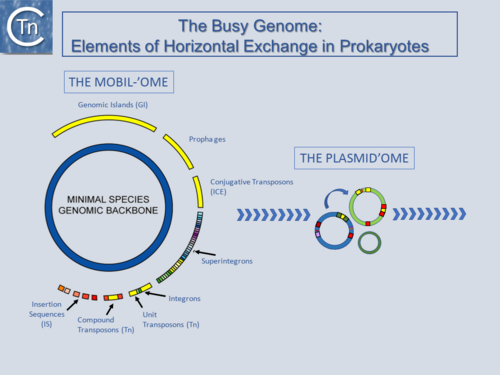General Information/Overview

The idea that many prokaryotic genomes are mosaic, composed of a "central genome backbone" of essential and house-keeping genes (the core genome) interspersed with DNA segments constituting the "mobilome" (a variety of accessory genes that form part of the pan-genome)(Fig.1.1.1), is now common currency [1][2].
The mobilome embraces several types of genetic units which, as their collective name indicates, can move from place to place in a particular genome or from cell to cell. These mobile genetic elements (MGE) can be divided into two major groups: those, such as plasmids and bacteriophages, that are transmissible from cell to cell (the intercellular MGE), and those that cannot themselves undergo transfer but which are transferred following integration into members of the first group (the intracellular MGE).
Intracellular MGE or transposable elements (TE) include transposons (Tn) and insertion sequences (IS) but can embrace integrons (In) [3][4] and introns [5][6][7].
Originally Tn were distinguished from IS since they carry passenger (also called cargo) genes not involved in catalyzing or regulating TE movement. Most eukaryotic DNA transposons have relatives among the prokaryotic IS (see [8]) and it is not surprising that a variety of these elements carrying passenger genes are now also being identified [9][10].
Prokaryotes harbor a host of such elements as well as several types of structure possessing characteristics of both groups (e.g. Integrative Conjugative Elements, ICE, originally called conjugative transposons, as well as other types of non-conjunctive genomic islands) [11][12][13].
Bibliography
- ↑ Medini D, Donati C, Tettelin H, Masignani V, Rappuoli R . The microbial pan-genome. - Curr Opin Genet Dev: 2005 Dec, 15(6);589-94 [PubMed:16185861] [DOI] </nowiki>
- ↑ </nowiki>
- ↑ </nowiki>
- ↑ </nowiki>
- ↑ </nowiki>
- ↑ </nowiki>
- ↑ </nowiki>
- ↑ </nowiki>
- ↑ </nowiki>
- ↑ Bao W, Jurka J . Homologues of bacterial TnpB_IS605 are widespread in diverse eukaryotic transposable elements. - Mob DNA: 2013 Apr 1, 4(1);12 [PubMed:23548000] [DOI] </nowiki>
- ↑ </nowiki>
- ↑ Dobrindt U, Hochhut B, Hentschel U, Hacker J . Genomic islands in pathogenic and environmental microorganisms. - Nat Rev Microbiol: 2004 May, 2(5);414-24 [PubMed:15100694] [DOI] </nowiki>
- ↑ </nowiki>